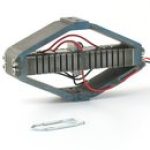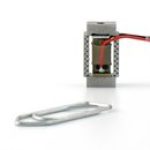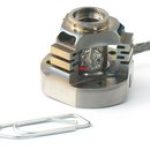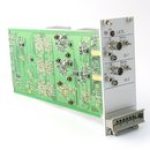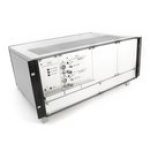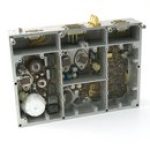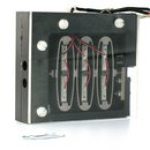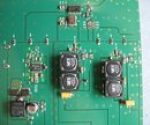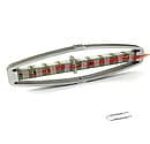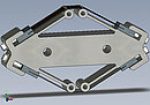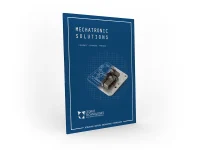Piezo actuators and electronics
Piezoelectric actuators, according to the broadest meaning, cover a wide range of concepts. Potentially, all devices using one of the piezo effects can be considered as piezo actuators. To be more specific, the following classification can be applied based on effects and uses.
The direct piezoelectric effect has been discovered by Pierre and Jacques Curie in 1880: Applying a mechanical pressure on some crystals as Quartz or Rochelle Salts generates electric charges. This effect is used to develop sensors for dynamic force or electric generators for vibration energy harvesting. Standard piezo actuators from CEDRAT TECHNOLOGIES such as APA® can be used for such applications because the direct piezoelectric effect is naturally present in all piezo actuators. CEDRAT TECHNOLOGIES can also develop customised piezo sensors and generators as presented in the related other sections.
The inverse piezoelectric effect, the key effect used to realise piezo actuator functions, consists in the deformation of a piezoelectric material due to the applied electric field.
Since the 60s, the most usual materials for actuators have been the PZT (Lead Zirconate Titanate) ceramics. Bulk piezo ceramics are poled and covered with external electrodes to generate the electrical excitation field. They offer deformations in the range of 300ppm with field of 600kV/m. This field requires high voltages, except at resonance, because the Q factor allows a full deformation with a reduced voltage. This method leading to ‘resonant actuators’ was at first developed by Paul Langevin in 1917 to build sonar transducer emitters. It is still used by CEDRAT TECHNOLOGIES in various vibration, sound and ultrasound generators as well as detection systems.
The multi layer piezo ceramics (MLA) have been developed in the 90s to reduce the required voltage outside resonance. Thanks to a structure based on PZT layers of 50 to 100µm placed between internal electrodes, the maximum electric field can reach up to 2MV/m with a voltage of less than 200V, leading to an active deformation of about 1000ppm. In a restricted sense, piezo actuators cover controllable actuators using these multi-layer piezo ceramics to make solid-state actuators using electrically-induced deformations.
CEDRAT TECHNOLOGIES’ Standard piezoelectric actuators, such as the PPAs & the APA®have been using these piezo materials this way for more than 10 years. In the context of its space activities, the multi layer piezo ceramics available on the market are compared in terms of performance and reliability for the benefice of its space and non-space customers.
Customized or new piezoelectric actuators and associated electronics developed by CEDRAT TECHNOLOGIES are presented in the following examples: A hollow piezo actuator, a double amplification actuator to get millimetres strokes, an amplified piezoelectric actuator with re-enforced pre-stress to survive large external vibrations (for space applications), extremely small (micro) to extremely large actuators …
Also developed by CEDRAT TECHNOLOGIES and presented in other sections, Piezo Mechanisms and Piezo Motors are more complex devices that can also be considered as piezo actuators.
To learn more about our piezo actuators see our related publications on piezo actuators .
Micro Piezo Actuators
Miniature piezo actuator and drive electronic based on a standard Amplified Piezoelectric Actuator
Applications
Aeronautics, Microtechnologies, Robotics, UAV…
STATUS
Prototype
Amplified Piezoelectric Actuators: APA120ML-PP
The Parallel Prestress (PP option) in an Amplified Piezoelectric Actuator allows to double its resistance to vibrations. Techno developped with Cnes (French Space Agency) for embedded telescops on statellites. See APA 120ML-PP case.
Applications
Aerospace, Optics, Refocusing mechanism, improved resistance to launching vibrations
STATUS
Space evaluated
Parallel Pre-stressed Actuator: PPA10M
The Actuator PPA 10M is designed according to space rules and in particular to avoid stick – slip behaviour.
Applications
Instrumentation, Aerospace, Optronics, Laser cavity, etc…
STATUS
Space qualified prototype
Hollow Parallel Pre-stressed Actuator: HPPA
The HPPA is a Direct Piezo Actuator with a 8 mm diameter internal hole
Applications
Refocussing, Optical Delay Line, Laser cavity, etc…
STATUS
Space qualified prototype
LA75 OEM
The LA75 OEM is the OEM and standalone version of the standard LA75 product. This version can drive and control a piezoelectric actuator.
Applications
Piezo actuators, standalone piezo driver
STATUS
Proof of concept
Switching amplifier SA75D
The SA75D is a new high power amplifier dedicated to supply piezo-electric actuators. Using high frequency PWM with a specific topology for piezo-electric loads, the SA75D offers large power and a very low ripple. These special features make the SA75D perfect for dynamic and precise motion applications. The SA75D is developed with the G2ELAB in the frame of the Avibus project.
Applications
Piezo actuator, high dynamic, low losses
STATUS
Prototype
Space Driving Electronics: FB-LA75
The driving and control electronic FB-LA75-space has been designed according to space rules.
Applications
Aerospace, Piezo Actuators, etc…
STATUS
Space evaluated
Super Amplified Piezoelectric Actuators for MRI
Non magnetic, long stroke piezo actuator has been designed for MRI integration
Applications
MRI, Medical, Non magnetic, etc…
STATUS
Prototype
Battery-based power supplies for embedded actuators, sensors & mechatronic systems
Power supplies for piezo or magnetic actuators, sensors & mechatronic systems based on 3.7V (typical) lithium polymer cells voltage.
Applications
Embedded piezo & magnetic actuators, motors, sensors, mechanisms, valves
STATUS
Proof of concept
Active smart Flaps & Fins
Long stroke, high force, ligth-weight Amplified Piezoelectric Actuators for making active flaps of helicopter blades and smart fins of Unmanned or Micro Aerial Vehicles (UAVs, MAVs), rockets and missiles. Project in cooperation with ONERA.
Applications
Aerospace, Helicopter, Missile, UAV, MAV, etc…
STATUS
Prototype
Electro-active polymers (EAP)
Electro-Active Polymers (EAP) receives growing interests due to some outstanding reported electromechanical performances. This may allow designing new active devices. Most of these outstanding performances (strain up to 300 %) have been reported on pre-tensioned devices.
Applications
Actuators, long stroke, low cost
STATUS
Demonstrator



